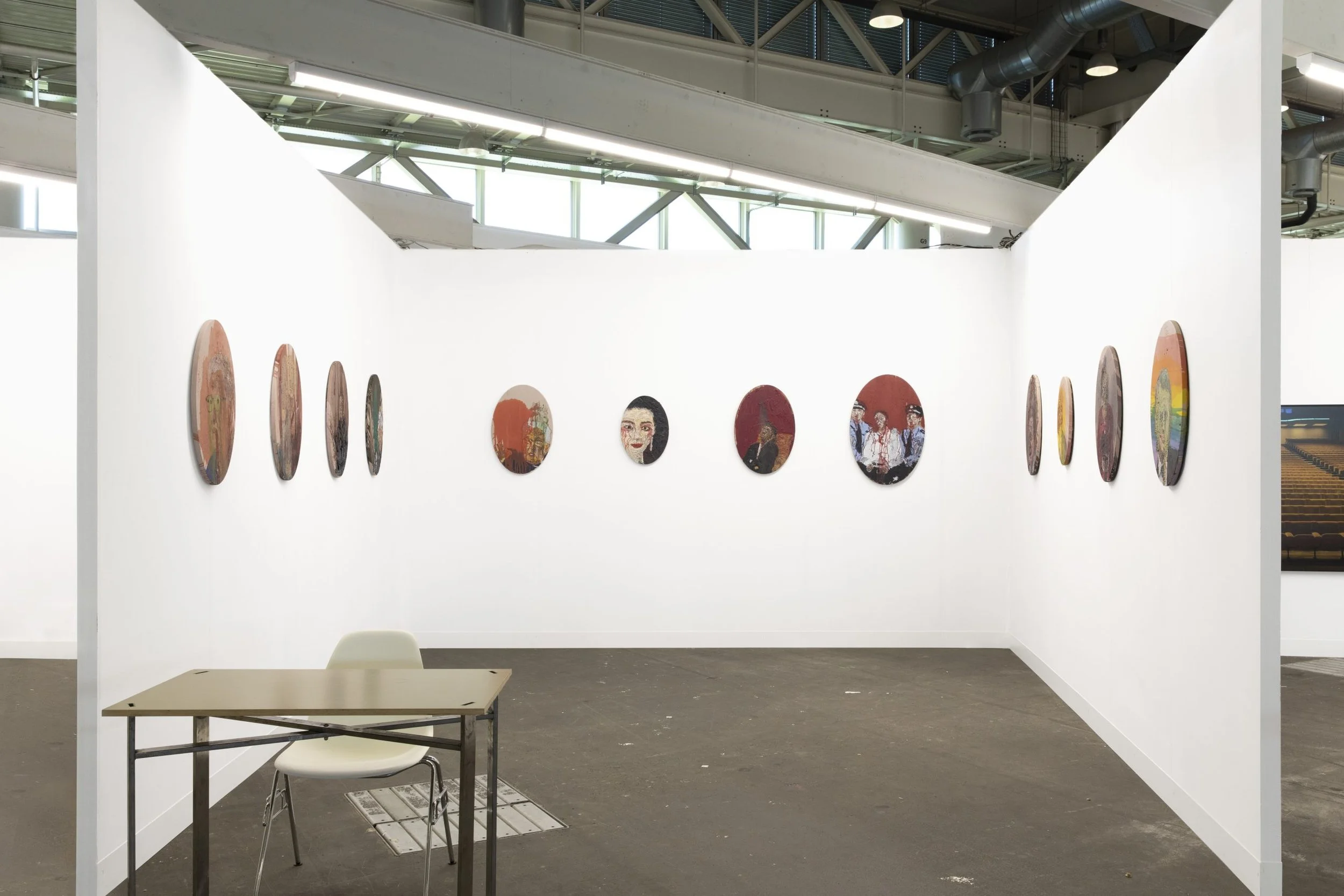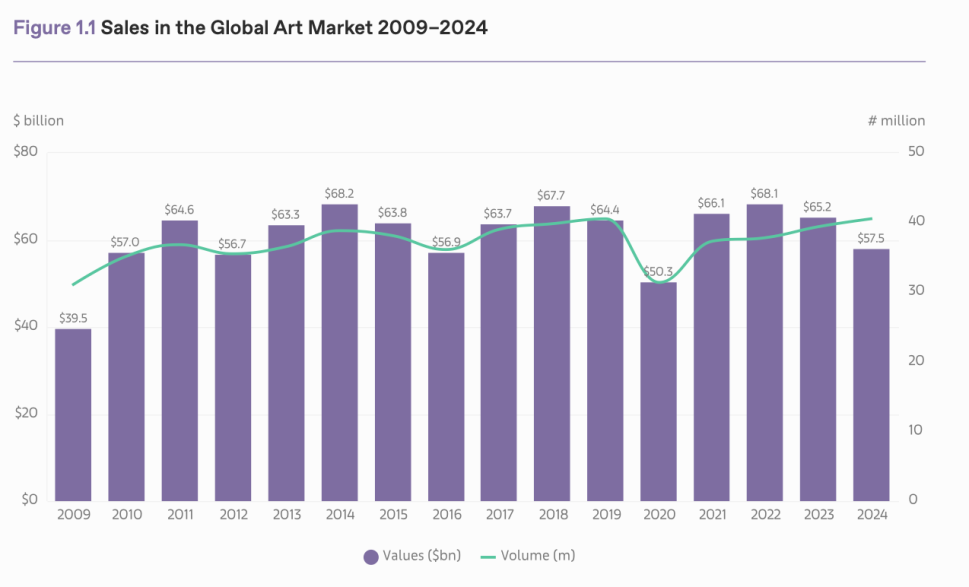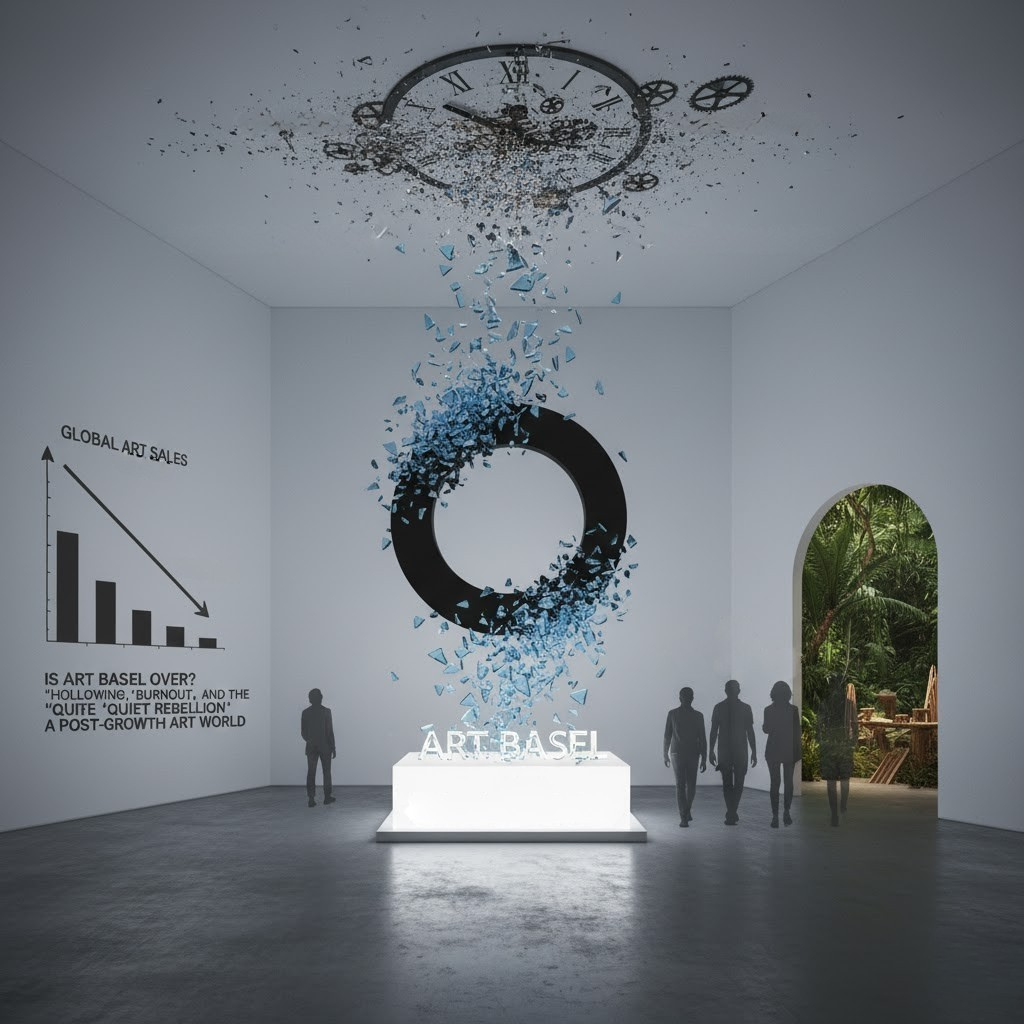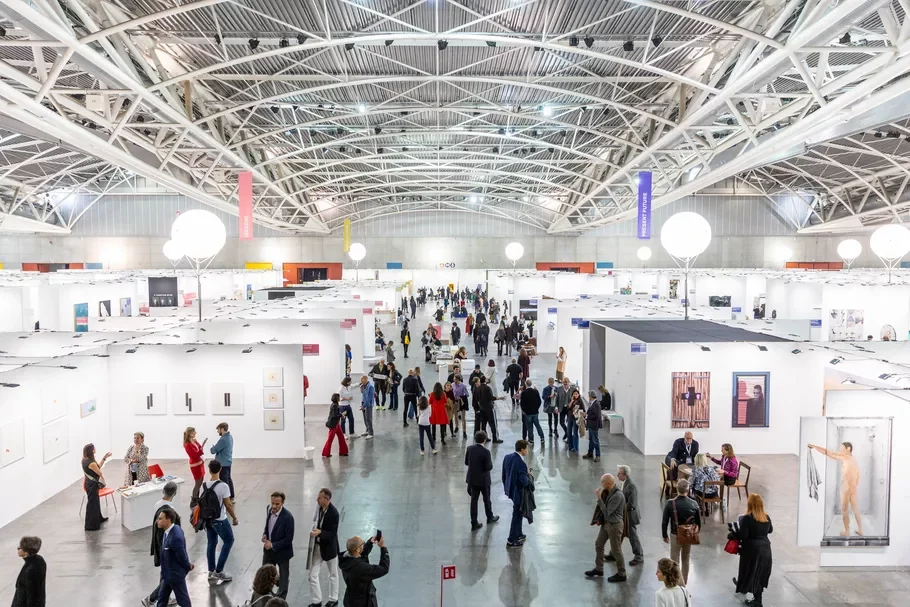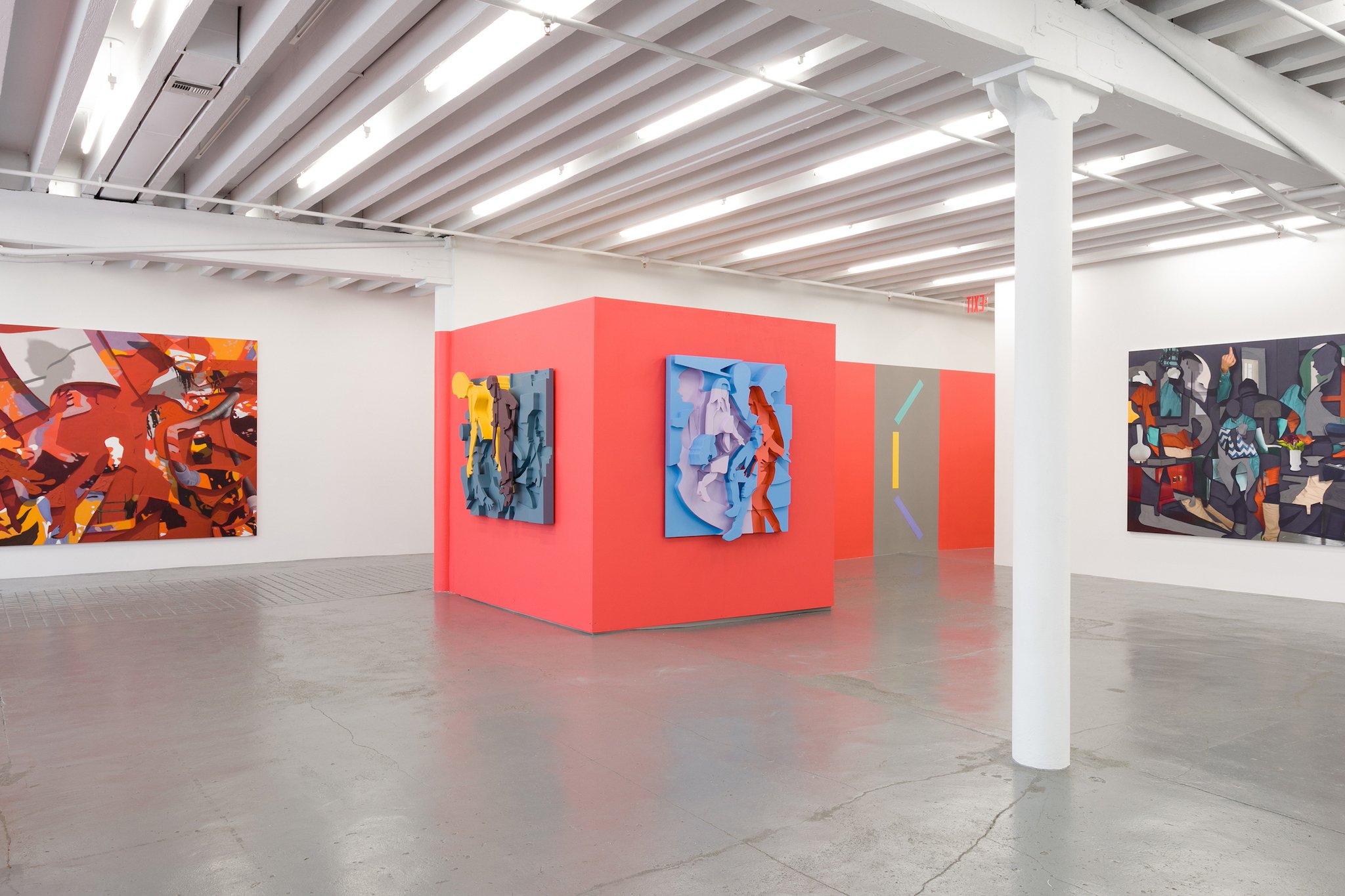Is Art Basel Over? Hollowing, Burnout, and the Quiet Rebellion Sparking a Post-Growth Art World
The proposition that the 2025 art market is experiencing a "hollowing" is no longer a hypothesis; it is a confirmed event, crystallized by a definitive strategic consensus. The uniform withdrawal of an entire cohort of eight significant, blue-chip exhibitors from Art Basel Miami Beach serves as the definitive signal of this structural shift. This unified defection—by galleries including Miguel Abreu, Chantal Crousel, Alison Jacques, Peter Kilchmann, Edward Tyler Nahem, Luisa Strina, Lia Rumma, and BANK—is not a random, partial schism but a calculated, shared response to a system that has reached its logical and financial breaking point.
These eight "Post-Growth Defectors" have, in unison, employed a "different calculus" for survival and relevance. Their consensus provides a powerful thesis: the current market pressures are forcing a collective rejection of the traditional "fair loop," revealing a clear and irreversible pivot toward a Post-Growth philosophy of value. This study will analyze the anatomy of this market recalibration, from the economic collapse and systemic burnout that forced it, to the philosophical state of hyperreality that defines it, and finally, to the new, decentralized ecology that is emerging in its wake.
The strategic defection of eight major galleries from Art Basel Miami Beach is a clear signal of the "hollowing" of the mega-fair. This calculated consensus reveals a system at its breaking point, where the high-cost spectacle is being replaced by a necessary, and quiet, pivot to a Post-Growth philosophy.
Part I: The Economics of Exhaustion: Anatomy of a Margin Collapse
The strategic consensus of the eight defectors is a direct consequence of a profound margin collapse, where the economic model of the mega-fair has become an untenable proposition. This collapse is not the result of a single factor, but rather an "economic vise" created by the toxic confluence of escalating costs, plummeting utility, and compressing margins.
First, the cost of entry—the "buy-in" to the traditional luxury system—is immense. Participation in a fair of Art Basel's stature, by the time booth fees, shipping, insurance, and entertainment are tallied, requires a financial outlay that can range from $150,000 to over $320,000 for a large gallery. This represents a non-negotiable, premium fixed cost that galleries must pay simply for access to the marketplace.
Second, the utility of this expenditure is in freefall. The primary function of the fair—to serve as a central marketplace for transactions—is fundamentally eroding. According to the 2024 Art Basel and UBS Art Market report, the share of annual sales that dealers make at art fairs has plummeted from a high of 46% in 2018 to just 29% in 2023. Galleries are thus paying escalating premium costs for access to a marketplace that constitutes an ever-shrinking portion of their annual income.
The "softening market" is a quantitative reality, as this data from the Art Basel and UBS report confirms. The 2024 drop in overall sales value provides the macro-economic backdrop for the "economic vise." While facing these shrinking market-wide revenues, galleries' share of sales at fairs has also plummeted to just 29%. This is the margin collapse in action: paying premium costs for a shrinking piece of a shrinking pie.
Third, the 2025 "softening market" has metastasized into a confirmed "buyer's market," creating the final blade of the vise. This market is defined by a "lack of urgency" from collectors, who feel empowered to negotiate, aware that galleries have already incurred massive sunk costs. This dynamic compresses margins further, with widespread reports of collectors successfully demanding steep discounts of 20-30% below the asking price, even on primary market works.
This triad of unsustainability creates the "margin collapse". Galleries are forced to pay a premium (up to $320,000) for the "privilege" of accessing a shrinking market (29% of sales) where their margins are then guaranteed to be compressed (by 20-30%). This economic model is broken. It is, as the analysis concludes, "no longer financially viable for many to participate 'just for show'". This economic pressure is the "forcing function" that united the defectors in their strategic withdrawal.
Part II: The 'Burnout Society' in the White Cube
This quantitative margin collapse is mirrored by a qualitative crisis of human and systemic fatigue. The art market's "state of exhaustion" is no longer a theoretical diagnosis; it is an empirical reality. This crisis is the art-world equivalent of the "Burnout Society" and the "relentless cycle... that kills creativity," concepts identified in the foundational studies of Post-Luxury Conceptual Functional Art (PLCFA).
The 2024-2025 period has been defined by a wave of high-profile, influential gallery closures, including Tim Blum, Adam Lindemann's Venus Over Manhattan, CLEARING, and the 80-year-old Marlborough Gallery. The stated rationales for these closures are not always simple financial collapse, but a conscious rejection of the system's logic. Dealers are explicitly citing "systemic exhaustion" (Tim Blum), "fatigue with the pace and pressure of the business" (Adam Lindemann), and the inescapable trap of the "fair loop"—the relentless need to "keep up with scale and pace" (gallerist Dooyong Ro). This sentiment directly echoes the "less than stellar" verdict on Art Basel delivered by Miguel Abreu.
This burnout is the human cost of maintaining the hyperreal spectacle. The "fair loop" is the "Burnout Society" in practice, an engine that requires a level of production, travel, and capital burn that is fundamentally inhuman. To continue participating, despite knowing the detrimental financial and psychological costs, evokes a sense of l'appel du vide—the inexplicable "call of the void," a seemingly irrational compulsion towards a known destructive path, driven by the system's relentless momentum. This "systemic exhaustion" is catalyzing what has been termed "the big slowdown". Across the entire art ecosystem, institutions are being "forced to scale back". Museums like V&A Dundee are shifting from multiple major exhibitions to a single, nine-month show per year, while galleries are being forced to adopt a "slower, more considered approach to business".
The "hollowing" identified in the query is, therefore, not a new event to be studied. It is the pre-existing condition of the entire growth-oriented art market, a system "hollowed out" by its own unsustainable pace. The 2025 market is simply the moment the symptoms became too acute to ignore.
The conceptual "hollowing" of Art Basel is the visible symptom of a pre-existing condition: a market system "hollowed out" by its own unsustainable pace. This visual encapsulates the economic decline and systemic "burnout" that has pushed the art world to a critical inflection point, where the traditional model is shattering, and a new paradigm is being forced into existence.
Part III: The Art Fair as Simulacrum: A Baudrillardian Critique
To fully grasp the "hollowing" of the mega-fair, one must apply the precise philosophical lens of Jean Baudrillard (Baudrillard), identified in PLCFA studies as the "single most critical step" in fortifying the Post-Luxury concept. Art Basel, in its 2025 iteration, has become a perfect Baudrillardian simulacrum—a "hyperreal" space that has become completely detached from its original function.
The PLCFA framework posits that traditional luxury has progressed from use-value (the object's function) and exchange-value (its price) to "sign-value" (its status as a marker). The traditional art fair system no longer sells objects but "signs of luxury". The primary "product" of Art Basel is no longer the art itself, but the sign of Art Basel—the brand, the spectacle, the VIP access, the "celebration of ego and pretentiousness". The fair's function is to "re-energize a system of signs," a closed loop of advertising detached from material reality.
This is the world of the simulacrum, "where the map precedes the territory". At Art Basel, the map—the official exhibitor list, the VIP preview, the celebrity sightings, the social media spectacle—is the product. This is the "sign-value" that galleries purchase for $320,000. The territory—the "visceral," "physical encounter" and "meaningful" dialogue with a work of art—is rendered secondary, if not impossible, by the "volume and velocity of transactions".
The definitive proof of this hyperreal state is the fact that the most desirable work is often "pre-sold to VIPs before the fair even opens to collectors". If the art is already sold, what is the function of the fair? It is not a marketplace; it is a pure spectacle, a high-cost, high-burnout ritual to be seen participating in the system. The "hollowing" is this very state of hyperreality. The system is "hollow" because its "sign-value" has become "detached from any material or functional reality".
This hollowing is driven by the PLCFA framework's "Scarcity Paradox": the condition "where mass expansion has destroyed the very rarity it purports to sell". The mega-fair's business model is this paradox in action. The core promise is exclusivity, yet the brand's global expansion (Basel, Miami Beach, Hong Kong, Paris) and the corresponding explosion of satellite fairs create an overwhelming, mass-market experience. The result is not a curated presentation of rare objects, but a "garage sale for galleries", an "over-saturation" of the market where "the buying power can't keep up with the growth". This mass expansion destroys the aura of rarity, leaving only the hollow "sign-value" of the brand itself.
The mega-fair is a perfect Baudrillardian simulacrum: a "hyperreal" space where the product is not the art but the spectacle itself. This is the "Scarcity Paradox" in action—a mass-market, overwhelming experience that, through its global expansion, destroys the very rarity it purports to sell. The fair's function becomes a high-cost ritual, a "garage sale for galleries" hollowed out by its own over-saturation.
Part IV: The 'Post-Growth' Defection and the 'Artisan Activist'
The "buyer's market" of 2025, with its "hesitancy" and demands for 20-30% discounts , is the physical manifestation of the PLCFA concept of a "quiet rebellion" . Collectors are, in effect, refusing to subsidize the hyperreal "sign-value" of the fair by overpaying for the object. This rebellion, combined with the economic and systemic burnout, has forced the strategic response of the eight defectors.
The uniform "Leave" strategy of Miguel Abreu, Chantal Crousel, Alison Jacques, and their cohort represents a definitive pivot to the "Post-Growth" model, a core territory of the PLCFA critical project. These eight galleries are consciously opting out of the high-burnout "fair loop" and rejecting the "economic mandate of perpetual growth" that the mega-fair represents.
The calculus provided for Miguel Abreu is a perfect case study: facing a "less than stellar" experience in Miami, he opted for Frieze Masters and Art Basel Paris, stating, "Three fairs in the fall would be too much". This is not a failure to compete, but a strategic rejection of the "fair loop" and the "systemic exhaustion" that defines the old model.
This strategy can be understood as the "Gallery as Artisan Activist," an application of the PLCFA concept, "The Artisan as Activist". This framework identifies creators who reject the "obsession with scale" and the "traditional... calendar" not as a business constraint, but as a "philosophical and political" act. By exiting Art Basel Miami, these galleries are making a "conscious limitation of production"—in this case, the "production" of high-cost, high-burnout fair booths.
They are swapping the volume of the fair for the value of "Narrative Control". Their capital and energy are being reinvested in more sustainable, controlled, and narrative-rich activities that align with PLCFA values:
Curated In-Gallery Exhibitions: Focusing on deep, "transformed" experiences within their own spaces, such as Alison Jacques' 2025 programming in London and Miguel Abreu's robust in-house schedule of convenings.
Museum & Institutional Placement: Cementing artists' long-term legacies over short-term sales, a key strategy for galleries like Chantal Crousel.
Strategic Fair Participation: This is not an anti-fair policy, but a selective one. As seen with Abreu, Lia Rumma, and Peter Kilchmann, participation is focused on specific markets (e.g., European editions) to avoid the specific fatigue and "less than stellar" returns of the Miami iteration.
This "Post-Growth" strategy is the direct antidote to the "Scarcity Paradox." Where the mega-fair offered mass-marketed, false scarcity, the "Artisan Activist" model creates authentic, controlled, and narrative-driven scarcity. This is a definitive pivot to a model where value is defined by "durability, craftsmanship, [and] cultural relevance... over novelty and hype".
This is the 'Gallery as Artisan Activist' in practice. By defecting from the high-burnout "fair loop," galleries are re-investing in what they truly control: the "narrative-rich," curated in-gallery exhibition. This Post-Growth model swaps the mass-market volume of the mega-fair for the authentic, long-term value of a deep, considered encounter with the art itself.
Part V: Thesis: The 'Hollowing' as a 'Re-Potting'
This analysis provides a comprehensive thesis. The events at Art Basel Miami 2025 are, unequivocally, a "sign of hollowing". This "hollowing," however, is not a simple void. It is the "systemic exhaustion" of the 20th-century, growth-obsessed, "hyperreal" model of luxury consumption. The 2025 "buyer's market" did not cause this collapse; it merely acted as the "forcing function" that exposed this hollow state and made its economic model untenable.
Crucially, the "hollowing" of the mega-fair is not a death, but a "re-potting". The "systemic exhaustion" of the old, centralized model is the necessary condition—the compost—for the growth of a new, decentralized, "Post-Growth Art Ecology".
The "hollowing" of the mega-fair is not a death, but a "re-potting." The rigid, concrete structure of the old, growth-obsessed system has finally cracked. From those fissures, a new Post-Growth Art Ecology is emerging—not as a simple weed, but as something vibrant, exotic, and unexpectedly beautiful. This is the new paradigm: radical, sustainable, and narrative-rich models blooming in the most unlikely of places.
The "hollow" space is not remaining empty. It is being filled by "The Decentralized Atelier," the practical application of the PLCFA framework's "Territory II: The New Patrons". This new ecosystem is a "fundamental restructuring of power, ownership, and community" and includes several key components:
Niche & Curated Fairs: Galleries are opting for smaller, focused fairs like Independent. This fair's model succeeds by rejecting the mega-fair's logic. It increases curatorial value while strategically lowering price points—focusing on the $10,000-$20,000 range—to directly meet the "quiet rebellion" of the new, more hesitant buyer.
Collaborative & "Post-Growth" Models: Galleries are rejecting the "solo genius artist-producer" model in favor of collaborative structures like shared booths, shared gallery spaces (e.g., Condo), and co-operative fairs (e.g., Art Collaboration Kyoto). This is a "Post-Growth" strategy to mitigate "systemic exhaustion," reduce costs, and build community.
Artist-Led & Anti-Scarcity Models: Radical models are emerging that directly "challenge the pretense of scarcity" that underpins the "Scarcity Paradox". Zero Art Fair, for example, gives priority access to collectors who "usually cannot afford to purchase art," acting as a pure "Artisan as Activist" intervention.
Sustainable & "Slow" Practice: The entire "big slowdown" is enabling a new focus on sustainable exhibition-making, with a focus on reducing waste and shipping. This directly aligns with the PLCFA principle of "The Slow Movement," a "cultural resistance to acceleration and disposability".
The "hollowing" of Art Basel is the "Systemic Critique" (PLCFA Definition) in action. The "strategic consensus" of the eight defecting galleries is the definitive, market-driven proof of the Post-Luxury paradigm. It signals the art world's final, necessary pivot from a "Post-Luxury" (PLCFA Definition) critique to a functioning, "Post-Growth" ecology.

